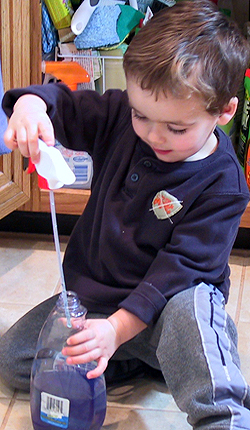MPC Public Education Coordinator Speaks at Child-Resistant Packaging Seminar
Presentation delivers real-world look at the importance of child-resistant packaging in preventing poisonings among young children.
By: Malissa Carroll
Monday, May 28, 2013

On May 9, Perritt Laboratories, Inc. hosted its annual Child Resistant Packaging Today© Seminar, featuring participants from the pharmaceutical, clinical, generic, unit packaging, and household products industries. Angel Bivens, RPh, MBA, CSPI, public education coordinator for the Maryland Poison Center (MPC) at the University of Maryland School of Pharmacy, addressed the seminar's attendees to emphasize the real-world implications of packaging certain products with child-resistant closures (CRCs).
"Approximately 50 percent of calls into poison centers involve children under the age of six," says Bivens. "There are some products where as little as a mouthful or a single pill can be significantly dangerous to a small child, so having these types of products in a child-resistant closure buys some time for parents to catch their children before they get into the substance."
The requirement for companies to package certain substances using CRCs is mandated by the United States' Poison Prevention Packaging Act. Created in 1970, this law is designed to prevent young children from accidentally ingesting hazardous substances that might be stored in the home. Some of the substances covered by this law include acetaminophen (Tylenol), aspirin, ibuprofen, mouthwash, furniture polish, solvents for paint or other coating material, and turpentine.
Bivens' presentation, which she titled "CRCs Save Lives," discussed the prevalence of unintentional poisonings among children under the age of six and explained the risk factors associated with unintentional poisonings in this age group. She provided examples of situations in which individuals attempted to circumvent the law, including one situation where a child drank a liquid that his or her parents had placed into a water bottle, but that had been originally packaged in a secure container using a CRC. "Had the adult left the substance in the original container with the child-resistant closure, perhaps this incident could have been avoided," she said.
However, Bivens' presentation also acknowledged that child-resistant packaging does not necessarily mean that the packaging is child-proof.
"As an industry, you have to make sure that parents are aware that child-resistant packaging is not child-proof," says Bivens. "When used, child-resistant closures can decrease the likelihood of poisonings, but given enough time, children can get into these packages. Proper storage and supervision is still needed."
In addition to Bivens' presentation, the seminar also featured speakers representing Perritt Laboratories, Inc., an independent testing laboratory that provides child-resistant package testing and microbiological testing services; the US Consumer Product Safety Commission, a government agency charged with protecting the public from unreasonable risks of injury or death associated with the use of thousands of consumer products under its jurisdiction; and the legal field.